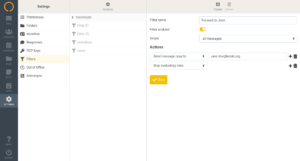Incoming mail is automatically processed by the server and handled/organized according to defined criteria. For example the server can be made to move the message to a specified folder, redirect it to another account, send a reply, discard, delete, etc when certain criteria is fulfilled.
Filtering is based on the Sieve language, which means that under the hood all filters are stored as a Sieve script on the server. This interface allows a user to define rules in easy way without the need to know the language.
Each filter definition has a name and set of rules and actions. Usually the number of definitions is unlimited.
Filter definitions can be grouped into sets. These can be activated or deactivated. Depending on server configuration there can be none, one or more active sets at the same time. Filter sets (scripts) need to have a unique name.
New sets can be created as empty or as a copy of an existing set. It is also possible to import them from a text file containing Sieve script. Sets in form of a script can be downloaded e.g. for backup or migration purposes.
A user can have up to a maximum of 5 filter sets (scripts) defined.
Every filter can be active or inactive, which is convenient if you want to disable some actions temporarily.
Because filters are executed in specified order (from top to bottom as you see them on the list) you can use drag-and-drop technique to rearrange filters on the list.
Every filter definition contains at least one rule and one action. Depending on server capabilities a rule can be based e.g. on message headers, body, date or size.
A set of actions also depends on server capabilities. Most servers support:
moving/copying messages to specified folder
redirecting/copying messages to another account
discarding messages with specified error message
replying (vacation)
deleting (ignoring) messages
setting flags (e.g. marking as Read).
Note: Some actions stop filtering process, some do not. Use ‘Stop evaluating rules’ and ‘Keep message in Inbox’ actions to have more control on this.

